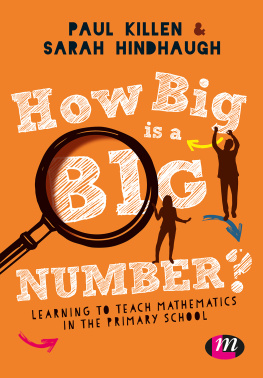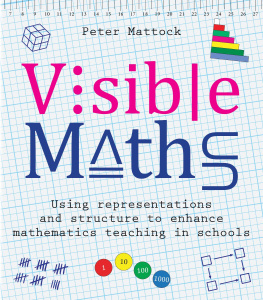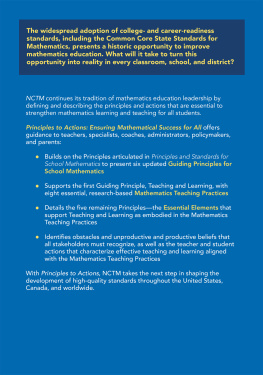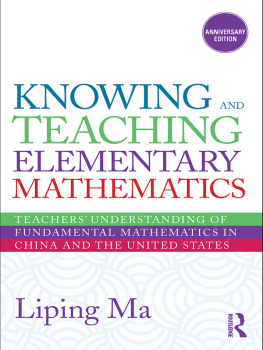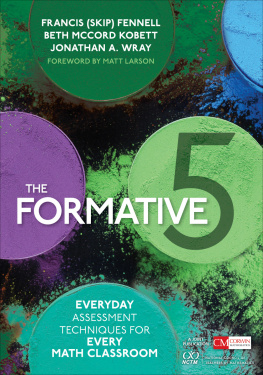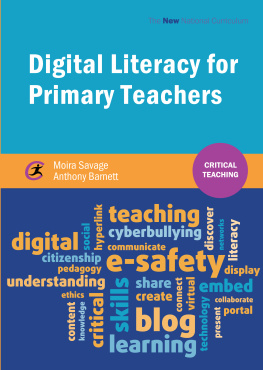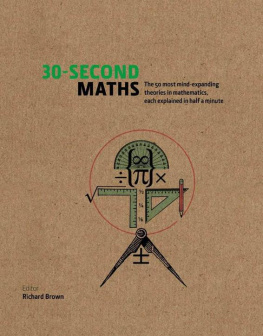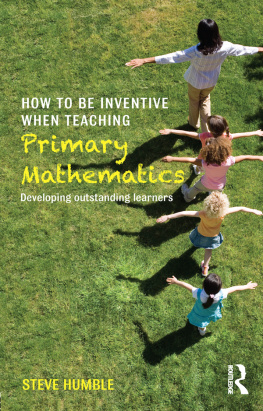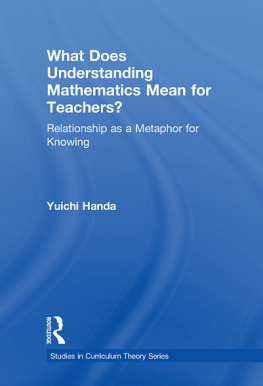Haylock - Mathematics Explained for Primary Teachers
Here you can read online Haylock - Mathematics Explained for Primary Teachers full text of the book (entire story) in english for free. Download pdf and epub, get meaning, cover and reviews about this ebook. City: London;Los Angeles, year: 2011;2010, publisher: SAGE Publications, genre: Children. Description of the work, (preface) as well as reviews are available. Best literature library LitArk.com created for fans of good reading and offers a wide selection of genres:
Romance novel
Science fiction
Adventure
Detective
Science
History
Home and family
Prose
Art
Politics
Computer
Non-fiction
Religion
Business
Children
Humor
Choose a favorite category and find really read worthwhile books. Enjoy immersion in the world of imagination, feel the emotions of the characters or learn something new for yourself, make an fascinating discovery.

Mathematics Explained for Primary Teachers: summary, description and annotation
We offer to read an annotation, description, summary or preface (depends on what the author of the book "Mathematics Explained for Primary Teachers" wrote himself). If you haven't found the necessary information about the book — write in the comments, we will try to find it.
Haylock: author's other books
Who wrote Mathematics Explained for Primary Teachers? Find out the surname, the name of the author of the book and a list of all author's works by series.
Mathematics Explained for Primary Teachers — read online for free the complete book (whole text) full work
Below is the text of the book, divided by pages. System saving the place of the last page read, allows you to conveniently read the book "Mathematics Explained for Primary Teachers" online for free, without having to search again every time where you left off. Put a bookmark, and you can go to the page where you finished reading at any time.
Font size:
Interval:
Bookmark:

Mathematics
Explained for
primary teachers

Education at SAGE
SAGE is a leading international publisher of journals, books, and electronic media for academic, educational, and professional markets.
Our education publishing includes:
- accessible and comprehensive texts for aspiring education professionals and practitioners looking to further their careers through continuing professional development
- inspirational advice and guidance for the classroom
- authoritative state of the art reference from the leading authors in the field
Find out more at: www.sagepub.co.uk/education


Mathematics Explained for
primary teachers
4th edition
Derek Haylock

Derek Haylock 2010
First edition published 1995
Second edition published 2001
Third edition published 2005, reprinted 2006, 2007, 2008, 2009
This fourth edition published 2010
Apart from any fair dealing for the purposes of research or private study, or criticism or review, as permitted under the Copyright, Designs and Patents Act, 1988, this publication may be reproduced, stored or transmitted in any form, or by any means, only with the prior permission in writing of the publishers, or in the case of reprographic reproduction, in accordance with the terms of licences issued by the Copyright Licensing Agency. Enquiries concerning reproduction outside those terms should be sent to the publishers.
SAGE Publications Ltd
1 Olivers Yard
55 City Road
London EC1Y 1SP
SAGE Publications Inc.
2455 Teller Road
Thousand Oaks, California 91320
SAGE Publications India Pvt Ltd
B 1/I 1 Mohan Cooperative Industrial Area
Mathura Road
New Delhi 110 044
SAGE Publications Asia-Pacific Pte Ltd
33 Pekin Street #02-01
Far East Square
Singapore 048763
Library of Congress Control Number: 2010922538
British Library Cataloguing in Publication data
A catalogue record for this book is available from the British Library
ISBN 978-1-84860-196-3
ISBN 978-1-84860-197-0 (pbk)
Typeset by C&M Digitals (P) Ltd, Chennai, India
Printed and bound in Great Britain by Ashford Colour Press Ltd
Printed on paper from sustainable resources
Derek Haylock is an education consultant and author. He worked for over 30 years in teacher education, both initial and in-service, and was Co-Director of Primary Initial Teacher Training and responsible for the mathematics components of the primary programmes at the University of East Anglia (UEA), Norwich. He has considerable practical experience of teaching and researching in primary classrooms. His work in mathematics education has taken him to Germany, Belgium, Lesotho, Kenya, Brunei and India. He now works as an education consultant for a number of organizations, including the Training and Development Agency for Schools. As well as his extensive publications in the field of education, he has written seven books of Christian drama for young people and a Christmas musical (published by Church House/National Society).
Haylock, D. (1991) Teaching Mathematics to Low Attainers 812. London: Sage Publications.
Haylock, D. (2001) Numeracy for Teaching. London: Sage Publications.
Haylock, D. and McDougall, D. (1999) Mathematics Every Elementary Teacher Should Know. Toronto: Trifolium Books.
Haylock, D. and DEon, M. (1999) Helping Low Achievers Succeed at Mathematics. Toronto: Trifolium Books.
Browne, A. and Haylock, D. (eds) (2004) Professional Issues for Primary Teachers. London: Sage Publications.
Haylock, Key Concepts in Teaching Primary Mathematics. London: Sage Publications.
Haylock, D. and Cockburn, A. (2008) Understanding Mathematics for Young Children: A Guide for Foundation Stage and Lower Primary Teachers, Fully Revised and Expanded Edition. London: Sage Publications.
Haylock, D. with Manning, R. (2010) Student Workbook for Mathematics Explained for Primary Teachers. London: Sage Publications.
My thanks and genuine appreciation are due to the many trainee teachers and primary school teachers with whom I have been privileged to work on initial training and in-service courses in teaching mathematics: for their willingness to get to grips with understanding mathematics, for their patience with me as I have tried to find the best ways of explaining mathematical ideas to them, for their honesty in sharing their own insecurities and uncertainties about the subject and for thereby providing me with the material on which this book is based. I also acknowledge my indebtedness to Marianne Lagrange, Matthew Waters, Jeanette Graham and their colleagues at Sage Publications for their unflagging encouragement and professionalism. And, finally, my thanks are due to my wife, Christina, without whose support I could not have even contemplated writing a fourth edition of this book.
To accompany this book there are two sources of supporting material. The first is the Student Workbook for Mathematics Explained for Primary Teachers (Haylock with Manning, 2010). This book, written with my colleague at UEA, Ralph Manning, has been produced specifically to accompany this fourth edition. For each of of Mathematics Explained the workbook provides a set of tasks related to the mathematical content of that chapter, together with answers and further explanation. The tasks are of three kinds: checking understanding; using and applying; and learning and teaching.
The second is the Mathematics Explained for Primary Teachers website (www.sagepub.co.uk/haylock). Included on this website are 45 of the 62 check-ups from my book, Numeracy for Teaching (Haylock, 2001). This material relates directly to the demands of the Numeracy Test that must be passed by trainee teachers in England as a prerequisite for Qualified Teacher Status. Where relevant I indicate towards the end of various chapters the Check-Ups available on the website that can be used by readers looking for further practice but with a focus on the application of the mathematical knowledge and skills to the job of being a teacher. In addition, the website contains a comprehensive glossary of the key terms used in this fourth edition of Mathematics Explained for Primary Teachers. This combines all the glossaries at the ends of chapters into a single list in alphabetical order.
Along with other relevant information, web links and assorted material, the website will also provide details of how the content of this book, chapter by chapter, links to primary school national curricula for England, Wales and Scotland and the level descriptions within each attainment target.
Since the third edition of this book there have been a number of significant events in primary education in this country relevant to the learning and teaching mathematics. For example, there was the influential Williams Review of Mathematics Teaching in Early Years Settings and Primary Schools (Williams, 2008). This has reinforced again the key message of
Next pageFont size:
Interval:
Bookmark:
Similar books «Mathematics Explained for Primary Teachers»
Look at similar books to Mathematics Explained for Primary Teachers. We have selected literature similar in name and meaning in the hope of providing readers with more options to find new, interesting, not yet read works.
Discussion, reviews of the book Mathematics Explained for Primary Teachers and just readers' own opinions. Leave your comments, write what you think about the work, its meaning or the main characters. Specify what exactly you liked and what you didn't like, and why you think so.

